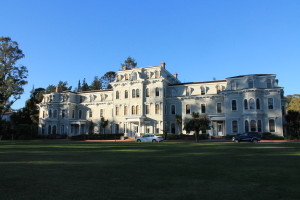On Wednesday, Feb. 28 people from across the Bay Area gathered in downtown San Francisco for an emergency rally to protest over 150 arrests in Northern California over the last few weeks by Immigration Customs and Enforcement.
Oakland Mayor, Libby Shaaf publicly warned the Bay Area community on Feb. 24th of possible ICE raids in the Bay Area over the next few days. While Oakland is a sanctuary city, many residents fear that this has instead made the city a target for ICE. Shaaf has since been receiving national criticism for her decision to warn the community.
The emergency rally was organized by multiple Bay Area groups gathered around the ICE headquarters of Northern California in downtown San Francisco. People physically blocked the building exits and others gathered at the intersection. Protesters linked arms to bar the intersection while others led chants and community members spoke about their personal experiences and urged others to stay vigilant, and to engage in local organizations to better support other families and individuals who may be at risk.
People of all ages were present including students from local high schools. Alyssa, a student at Balboa High School who declined to disclose her last name, said that she showed up to the action in support of her undocumented friends who have expressed fear of going to and from school. She and several of her classmates participated in a walkout to attend the protest.
“A lot of my friends are scared to leave the house. I’m hearing stories about how their grandparents are scared,” Alyssa said. “I’m expecting San Francisco to protect our immigrants, that’s what they’re supposed to do.”
Mills student Sophia Cook-Philips attended the emergency rally with others from the Catalyst Project. The Catalyst Project is an organization based in San Francisco committed to helping “build powerful multiracial movements that can win collective liberation,” according to their website.
Cook-Philips is an intern at the organization and attended a training to provide security at events like the rally. At the rally, she spent the time blocking streets and directing the flow of traffic.
Cook-Philips remains skeptical of government officials and urged that individuals be ready to take matters into their own hands.
“My fellow white students should show up and be ready to chip in to these organizing efforts that I think are really powerful,” Cook-Philips said.
During an open mic period the organizers welcomed community members to speak. Katrina Liwanag, a student and member of the League of Filipino Students at San Francisco State University, spoke on how the community can actively support the undocumented community.
“What do we do moving forward?” Liwanag said. “Number 1 is joining hands with our undocumented brothers and sisters, but not only people who are DREAMers, and people that are listed under DACA because not everybody has paperwork.”
Liwanag addressed the issue around the visibility of those who do not fall under the DREAMer narrative, but those who are left in limbo without security. Liwanag continued to urge people to join organizations that provide direct resources and attending as well as conducting Know Your Rights trainings, which teach people about their rights when interacting with ICE or the police.
Guadalupe Manzo spoke about her husband who had been detained by ICE earlier that morning during an open mic portion of the rally. Manzo traveled to the San Francisco facility only to be notified upon arrival that her husband was not there.
“There is nothing I can do but wait for their call,” Manzo said.


